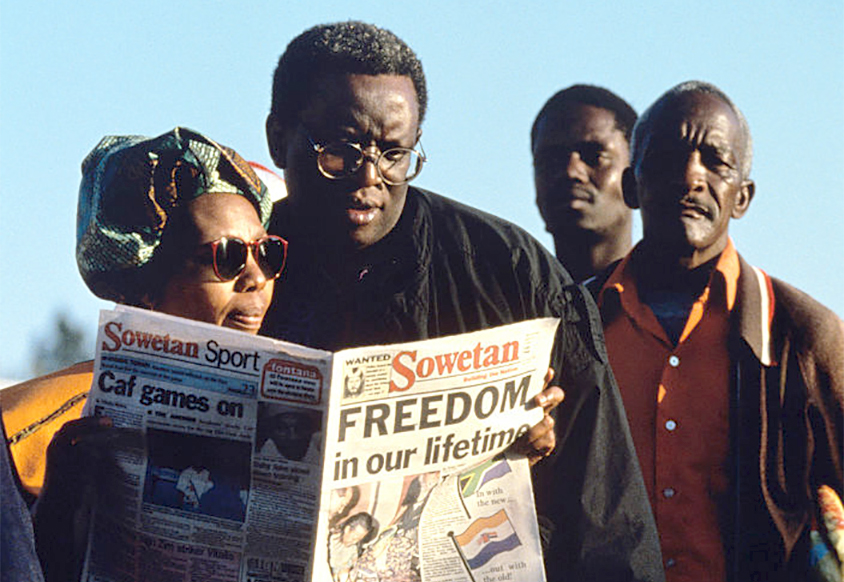Rise from the Ashes
by Warren L. Maye

Recent national and world events with respect to social, racial, and political unrest have in some ways hindered and in other ways helped the spirit of reconciliation among our diverse populations.
So, a burning question is, “How do we actually rekindle a sense of hope and restoration among people and rise from the ashes of pain and suffering in a post–COVID–19 world?”
By sharing an overview of the history of racial healing in The Salvation Army, this article will reflect on the initiatives that have brought The Salvation Army to where it is today, and hopefully enlighten and inspire you to do even greater, more effective work for the Kingdom.
The tumultuous 1990s
Racial reconciliation swept across the world in the 1990s like a mighty tsunami. Cape Town, South Africa, was its epicenter. After 27 years as a political prisoner there, Nelson Mandela emerged a free man and ultimately the nation’s president. Although most people rejoiced, others feared that black South Africans would seek revenge for the years they suffered under apartheid.
But then the words of Bishop Desmond Tutu, an Anglican cleric and Nobel Peace Prize winner, shook the world. The spiritual tsunami he unleashed swept hearts when he said, “Before Nelson Mandela was arrested in 1962, he was an angry, relatively young man. He founded the ANC’s military wing. When he was released, he surprised everyone because he was talking about reconciliation and forgiveness and not about revenge.”
To grant to those who mourn in Zion—to give them a beautiful headdress instead of ashes, the oil of gladness instead of mourning, the garment of praise instead of a faint spirit; that they may be called oaks of righteousness, the planting of the Lord, that he may be glorified.
— Isaiah 61:3 (ESV)
Tutu went on to further define what reconciliation would look like. “True reconciliation is never cheap, for it is based on forgiveness, which is costly. Forgiveness in turn depends on repentance, which has to be based on an acknowledgement of what was done wrong, and therefore on disclosure of the truth. You cannot forgive what you do not know.”
Tutu’s words washed over nations, cities, communities, churches, and homes everywhere. One of his most memorable statements will remain, “Forgiving and being reconciled to our enemies or our loved ones are not about pretending that things are other than they are. It is not about patting one another on the back and turning a blind eye to the wrong. True reconciliation exposes the awfulness, the abuse, the hurt, the truth. It could even sometimes make things worse. It is a risky undertaking but, in the end, it is worthwhile, because in the end only an honest confrontation with reality can bring real healing. Superficial reconciliation can bring only superficial healing.”
The Salvation Army weighs in
World leaders were deeply moved. General Paul A. Rader, then the international leader of The Salvation Army, was among them. During a heartfelt speech, he publicly admitted the organization’s failure to “stand up and be counted” during the years of apartheid in South Africa.
Then in 1998, Rader made another historic move. He appointed the then–Colonels Israel L. and Eva D. Gaither, an interracial couple and ministers in The Salvation Army, as leaders of the Southern Africa Territory. Mandela’s recent presidency had radically changed the political climate and helped make Rader’s selection to this post possible. The appointment of the Gaithers signaled to the world that the Army would now stand strong on racial equality.
Breaking racial barriers
Breaking racial barriers was nothing new for the Gaithers, who in their earlier years, had helped open doors for other interracial couples to step into Salvation Army training colleges in the United States. But they knew that this appointment would be daunting.
Israel Gaither later said, “Following the initial shock on receiving word of the appointment, I experienced an overwhelming feeling of inadequacy. It was at that point, as it has happened on previous occasions when we have received our ‘farewell orders,’ we again gave ourselves to the Lord in renewal of our covenant and commitment.”
Eva Gaither described her conflicting emotions: “I am anticipating, with great excitement, the opportunities for ministries which will be mine; and yet, I cannot help but have feelings of sadness over leaving family and friends in this great [Eastern] territory.” Nonetheless, she expressed her assurance in God’s word. “I will enter my new responsibilities confidently, believing that the same God who has equipped me in the past will continue to be with me in the future.” Eva took strength from the book of Jeremiah. “‘For I know the plans I have for you,’ declares the Lord, ‘plans to give you hope and a future,’” (29: 11). She added, “And I believe it!”
Doing what God wants
At their farewell service in New York City, Israel Gaither said to hundreds of colleagues, “I will be candid with you. We prefer not to leave. We haven’t finished our work here. But we have to yield to the will of the Lord. We cannot deny that this is what He would have us do.”
Gaither also pointed out that he believed reconciliation was also something necessary in the United States. He called on The Salvation Army to continue its own movement toward racial healing. “You must not allow forward movement to become strangled! I call on you to come together in unity and in love. Let reconciliation really happen—in this territory!”
It was clear Gaither’s message resonated with many Salvationists who faced their own struggles. People came forward in a steady stream to the altar. The Gaithers, in obeying the call to go to South Africa, set an example of what it means to, as a song often used in The Salvation Army says, “Go in the strength of the Lord.”
The Gaithers prepared themselves to enter a land of rich diversity, where people had come from a variety of ethnic backgrounds, including Zulu, Bantu, Xhosa, and Afrikaner. The Afrikaners were white descendants of Dutch, German, and French settlers. At that time, the Southern Africa Territory included the nations of South Africa, Mozambique, Lesotho, St. Helena, and Swaziland where the gospel was preached in 11 languages (today, Mozambique is its own territory).
Israel Gaither, who served as The Salvation Army’s first American–born black territorial commander, said, “Day by day, we are being confirmed and affirmed that this is what the Lord wants us to do.”
Launching a ‘Journey of hope’
On Oct. 29, 1998, Bishop Tutu’s Truth and Reconciliation Commission presented its report to President Mandela. The report was the result of nearly three years of exhaustive investigation. The tsunami of racial reconciliation rippled across the Atlantic and crashed against U.S. shores. Salvationists wrote letters to their church, divisional, territorial, and national leaders asking the Army to initiate a day of reconciliation in the United States.
At the College for Officer Training graduation ceremonies for the Builders of the Kingdom session, Commissioner Ronald G. Irwin, USA Eastern territorial leader, called for every Salvationist in the territory to repent of the sin of racism. His request came during the “Journey of Hope” program.
Irwin said the time was right because of “our long record of organizational and personal prejudice; our overt and subtle discrimination against other cultures and races, and particularly against people of color; our penchant for stereotyping, for making sweeping generalizations, for making judgments about people of other races and cultures; our ready tendency to give glib lip service to equality for all people and love for one another while harboring hatred in our hearts—all of this is shameful, a disgrace which cannot be tolerated, for it is blatantly unchristian, an embarrassment to God, and grieves the Holy Spirit!”
Irwin concluded, “And so I call upon Salvationists to join me in repentance, that we might be reconciled to God and to each other in Christian love so that our Army can be sacrificially involved in the creation of a world, free of racism and strife, making our Army an example of a communion of spirits in which such barriers no longer exist.” Some thought Irwin had overreacted. Others said he had hit the mark. In any event, Lt. Colonel R. William Hunter, then secretary for program for the East, said “‘Journey in Hope’” was “the beginning, not the destination.”
Taking decisive action
Today, the struggle for racial reconciliation is an ever–present challenge. Commissioner Israel L. Gaither, now retired from active service, says, “The long journey to racial reconciliation continues. It’s messy—and it can be a dangerous undertaking when there is a refusal to believe that God created humankind, in His image, and with the intention that we represent what He is like for the good of every human, regardless of race or ethnic identity.”
Gaither also offers the following steps.
Acknowledge what is offensive with a willingness to do something to bring correction. But if the heart is not transformed, behavior will not change and talk of reconciliation is received as nothing more than hollow words.
Consider the implications of the words we choose. Some terms that are invoked reveal an intent to categorize, diminish, and devalue individuals. Change is required in the way we think and speak of others created in the image of God.
Create opportunities to speak to one another—rather than at each other. Deeper conversations are urgently needed now. Silence is no longer acceptable.
Speak and listen with a true desire to understand and be understood. When we do this, then acknowledgement of wrong, repentance, forgiveness, and reconciliation is possible. There is hope.


